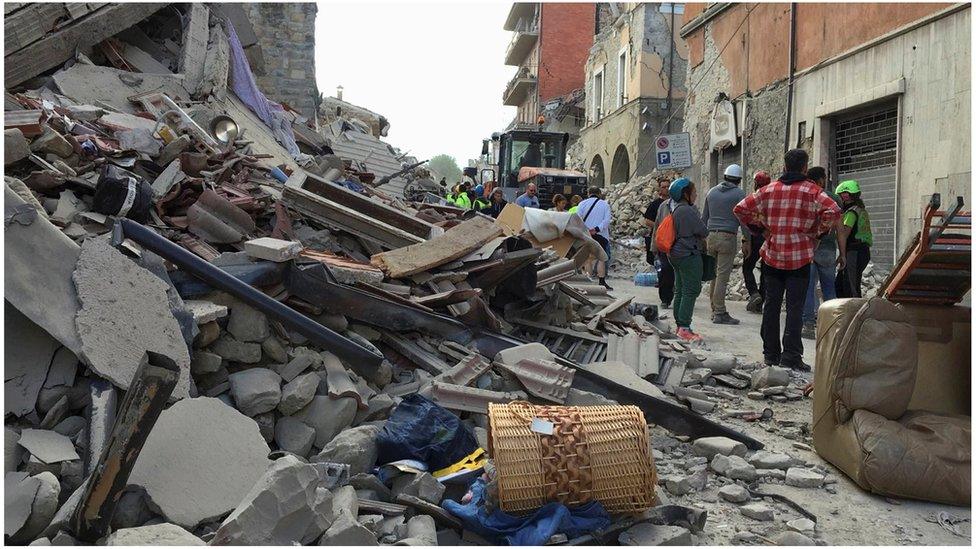Quakes 'ever present' for Apennines
- Published

Every so often, one of the faults that run along the Apennines will rupture
Quakes are the ever present danger for those who live along the Apennine mountain range in Italy.
Through the centuries thousands have died as a result of tremors equal to, or not much bigger than, the event that struck in the early hours of Wednesday.
We all recall the L'Aquila (Magnitude 6.3) event of 2009 in which 295 died. But go much further back to Avezzano (Magnitude 6.9-7.0) in 1915, which claimed 30,000 lives; and to 1703 when a trio of Magnitude 6 quakes killed at least 10,000 people.
Thankfully, we tend not to see deaths on those scales any more, and that is because of more robust building, better preparation and more co-ordinated emergency responses after the fact.
What doesn't change is the geological cause. On the grand scale, Italy's seismic problems are driven by the great collision between the African and Eurasian tectonic plates.
'Pull-apart'
But look closer at the specifics of any quake and the details are much more complicated. The Tyrrhenian Basin, or Sea, which lies to the west of Italy, between the mainland and Sardinia/Corsica, is slowly opening up.
Scientists say this is contributing to extension, or "pull-apart", along the Apennines which works at a rate of 3mm per year.
Add in movement in the Adriatic where the crust is rotating in an anti-clockwise direction, and you have a fiendishly complex picture. Italy is literally being pushed and pulled every which way.

"The Apennines are also very high; the crust is very thick there and there's a process of gravitational collapse," said Dr Richard Walters from Durham University, UK.
"So, there's a spreading of the Apennine mountain chain which also then leads to extension - the pulling part - and therefore the normal faulting earthquakes."
These are not the colossal tremors we see at tectonic plate boundaries where Magnitude 8 and 9 events will occur. But as history shows, Apennine quakes will certainly cause their share of misery.
"The effects are so devastating here because the quakes happen so shallow in the crust. And that's just due to the nature of the faults," explained Dr Laura Gregory from Leeds University, UK, who works in the region.
"They're really quite small faults but because they're shallow, the shaking is very dramatic right above where the quake happens."
Retrofitting
Computer models are now used to forecast the likely number of casualties in earthquakes - the number of dead and injured. These models factor in what's known about population density and local building codes.
The forecasts are used to give an early guide to emergency services to tell them what they're heading into. For Wednesday's quake, the forecasts are for deaths reaching perhaps a hundred or more, and injuries running into the hundreds.
How those numbers actually play out will depend on the quality of the buildings in which people were sleeping (the tremor hit at half-three in the morning).
The older building stock will have been at most risk - especially those properties that have not been retrofitted to make them stronger.
But there will keen interest in how some of the newer stock has performed. Too many buildings of recent heritage around L'Aquila suffered extensive damage, and there will be a critical assessment to see if the buildings further north in this latest quake have performed better.
Space view
Radar satellites will come over the Apennine region in the next couple of days to map the quake zone.
Their pictures will be compared with space images acquired before the tremor to see how the rocks have moved.
This will aid scientists on the ground as they try to understand precisely which fault ruptured and how.
It's information that can then be fed into future hazard assessments in the Apennines - to gauge for example if stress has been released or loaded on to neighbouring faults.
"Satellites help us see if the fault rupture came to the surface," said Dr John Elliott, also from Leeds University.
"In the case of L'Aquila in 2009, the surface breaks were quite small - only about 10cm - and it was quite hard at first for the geologists to find out which fault was actually responsible."
Follow Jonathan on Twitter., external